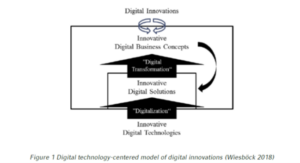Digital Innovations
The prevalence of digital technologies has led to the emergence of a new kind of innovation: digital innovations (Kohli and Melville 2018; Nambisan et al. 2017; Yoo et al. 2010). Especially IS research, but also various other research disciplines such innovation management, strategic management, or organizational economics, have dedicated a lot of effort regarding the nature of digital innovations. Existing theory defines digital innovation as “the creation of […] market offerings, business processes, or models that result from the use of digital technology” (Nambisan et al. 2017, p. 224). Accordingly, the use of digital technologies to create partly or entirely digital outcomes depicts a central element of digital innovations (Kohli and Melville 2018; Nambisan et al. 2017; Yoo et al. 2010).
This use of digital technologies makes digital innovations idiosyncratic in several dimensions. Firstly, the use of digital technologies during the innovation process breaks down the boundaries between the different innovation stages. Therefore, digital innovations show a clear tendency to unfold in a non-linear fashion (Nambisan et al. 2017). This goes so far that “with the infusion of digital technologies […] the scope, features, and value of product/service offerings continue to evolve even after the idea has been enacted” (Nambisan 2017, p. 1033). Secondly, the use of digital technologies for innovation purposes fosters the democratization of innovation through idea management platforms, design thinking approaches, and so on (Fichman et al. 2014). This is often accompanied by a shift towards more distributed innovation systems (Lyytinen et al. 2016). Similarly, modern organizations show an increasing tendency towards open innovation approaches that shifts the center of innovation from internal to external resources such as customers or business partners (Saldanha et al. 2017). Thirdly, through their modular architecture, digital technologies allow for a greater variety and flexibility in digital innovation outcomes. However, this may come at the cost of increased complexity and comprehensibility of digital products or services (Nambisan et al. 2017; Yoo et al. 2010).
Coming from an IS perspective, Wiesböck (2018) theorize digital innovations as a combination of two effects (digitalization1 and digital transformation) and three basic artifacts (innovative digital technologies, innovative digital solutions, and innovative digital business concepts).
Digitalization concerns the identification, adoption, adaption, development, and management of innovative digital technologies (Legner et al. 2017; Wiesböck 2018).
Digital transformation concerns the transformative impact of digital technologies on organizations (Legner et al. 2017; Wiesböck 2018).
Digital technologies capture the emergence of modern so-called SMAC technologies – social, mobile, analytics, and cloud computing (Legner et al. 2017).
Digital solutions refer to the fact that digital innovations are univerally based on the innovative (re)use IT components (Yoo et al. 2012; Fichman et al. 2014).
Digital business concepts mirror the fact that the emergence of digital technologies has led to the emergence of novel business solutions and business concepts based on novel IT solutions (Kohli and Melville 2018; Nambisan et al. 2017).
Figure 1 (Wiesböck 2018) shows this digital technology-centered conceptualization of digital innovations.
Following their model of digital innovations, the innovative use of abstract digital technologies allows organizations to develop specific innovative digital solutions. For example, companies in our days are changing their management IS based on in-memory databases and based on new technologies for the interaction between humans and machines. Such innovative digital solutions, then again, trigger the development of innovative digital business concepts that complement the underlying digital solutions. In our example, the company is changing their controlling processes based on modified solutions management IS solutions – for example, they can now discuss scenarios in board meetings.

Sumber:
Wiesböck, F., & Hess, T. (2018). Understanding the capabilities for digital innovations from a digital technology perspective (No. 1/2018). Arbeitsbericht.
Nambisan, S. 2017. “Digital Entrepreneurship: Toward a Digital Technology Perspective of Entrepreneurship.” Entrepreneurship Theory and Practice, 41(6), 1029-1055.
Nambisan, S./Lyytinen, K./Majchrzak, A./Song, M. 2017. “Digital Innovation Management: Reinventing Innovation Management Research in a Digital World.” MIS Quarterly, 41(1), 223-238.
Kohli, R./Melville, N. P. 2018. “Digital Innovation: A Review and Synthesis.” Information Systems Journal, 28(1), 1-24.



Comments :